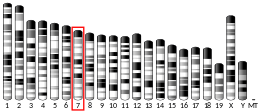Interleukin 30
Interleukin 30 (IL-30) forms one chain of the heterodimeric cytokine called interleukin 27 (IL-27), thus it is also called IL27-p28. IL-27 is composed of α chain p28 and β chain Epstain-Barr induce gene-3 (EBI3). The p28 subunit, or IL-30, has an important role as a part of IL-27, but it can be secreted as a separate monomer and has its own functions in the absence of EBI3.[5][6] The discovery of IL-30 as individual cytokine is relatively new and thus its role in the modulation of the immune response is not fully understood.
Function
IL-30 monomer is believed to have some functions similar to IL-27, even though there are more information and research on the IL-27 than IL-30. Both IL-27 and IL-30 alone can regulate inflammation by inhibiting Th17 cells production using STAT1 pathway. Although IL-30 has similar effect as IL-27 on the production of IL-17, it has a lower efficiency than IL-27.[7] If secreted as a monomer, IL-30 was observed to act as a suppressor of the IL-27 signalling pathway. Similar to subunit p40 of IL-12 which competitively bind to IL-12 receptor (IL-12R) complex, IL-30 most likely binds to IL-27 receptor (IL-27R) receptor and thus prevents the binding of IL-27.[8] Since part of IL-27R is subunit gp130, which is also part of IL-6R, IL-30 can also act as an antagonist for IL-6 and thus suppress the production of Th17 and Th1 cells.[9] Receptor subunit gp130 plays an important role in receptors for multiple cytokines, there is a possibility that IL-30 can affect also other cytokine signalling.
IL-30 can also form an alternative heterodimer with the EBI3 homolog cytokine-like factor 1 (CLF) called p28/CLF. This complex is produced by dendritic cells. p28/CLF binds to IL-6Rα and gp130 subunits of IL-6 receptor. It stimulates NK cells and thus increases production of IFN-γ. It can also induce production of IgG1c, IgG2c and IgM.[10][11]
Artificially, IL-30 can form a heterodimer with p40 β chain of IL-12 creating novel recombinant protein p28/p40 that is biologically active, which suggest the α and β chains of cytokines from IL-12 family may form different heterodimers in nature. This recombinant protein has suppressive effect on Th17 cells that comes from inhibiting the activation of STAT1 and STAT3 pathways, which are normally induced through gp130 receptor by IL-6 and IL-27. p28/p40 also inhibits the expansion of Th1 cells. Both of those functions could potentially be beneficial in treatment of some autoimmune diseases.[12]
It has been indicated that IL-30 plays a role in the regulation of prostate and breast cancer. It is linked with tumor progression as well as metastasization.[13][14]
Structure
IL-30 is a protein from the IL-6 cytokine family with molecular weight of 28 kilodaltons (thus the name IL27-p28). It is a member of the long-chain, 4-helix bundle family of cytokines, making it structurally similar to IL-6.[5]
The human gene for IL-30 is located on chromosome 16p11.[5] This gene for this molecule is now officially called IL-27 under HGNC guidelines.[15]
Therapeutic use
IL-30, or a heterodimer p28/p40, could potentially be used as an immunosuppressant for autoimmune and severe systematic inflammatory diseases.[8][12] IL-30 could also be a potential target for cancer treatment.[13]
References
- GRCh38: Ensembl release 89: ENSG00000197272 - Ensembl, May 2017
- GRCm38: Ensembl release 89: ENSMUSG00000044701 - Ensembl, May 2017
- "Human PubMed Reference:". National Center for Biotechnology Information, U.S. National Library of Medicine.
- "Mouse PubMed Reference:". National Center for Biotechnology Information, U.S. National Library of Medicine.
- Pflanz S, Timans JC, Cheung J, Rosales R, Kanzler H, Gilbert J, et al. (June 2002). "IL-27, a heterodimeric cytokine composed of EBI3 and p28 protein, induces proliferation of naive CD4+ T cells". Immunity. 16 (6): 779–90. doi:10.1016/S1074-7613(02)00324-2. PMID 12121660.
- Catalan-Dibene J, McIntyre LL, Zlotnik A (October 2018). "Interleukin 30 to Interleukin 40". Journal of Interferon & Cytokine Research. 38 (10): 423–439. doi:10.1089/jir.2018.0089. PMC 6206549. PMID 30328794.
- Stumhofer JS, Laurence A, Wilson EH, Huang E, Tato CM, Johnson LM, et al. (September 2006). "Interleukin 27 negatively regulates the development of interleukin 17-producing T helper cells during chronic inflammation of the central nervous system". Nature Immunology. 7 (9): 937–45. doi:10.1038/ni1376. PMID 16906166.
- Shimozato O, Sato A, Kawamura K, Chiyo M, Ma G, Li Q, Tagawa M (September 2009). "The secreted form of p28 subunit of interleukin (IL)-27 inhibits biological functions of IL-27 and suppresses anti-allogeneic immune responses". Immunology. 128 (1 Suppl): e816-25. doi:10.1111/j.1365-2567.2009.03088.x. PMID 19740343.
- Stumhofer JS, Tait ED, Quinn WJ, Hosken N, Spudy B, Goenka R, et al. (December 2010). "A role for IL-27p28 as an antagonist of gp130-mediated signaling". Nature Immunology. 11 (12): 1119–26. doi:10.1038/ni.1957. PMC 3059498. PMID 21057510.
- Crabé S, Guay-Giroux A, Tormo AJ, Duluc D, Lissilaa R, Guilhot F, et al. (December 2009). "The IL-27 p28 subunit binds cytokine-like factor 1 to form a cytokine regulating NK and T cell activities requiring IL-6R for signaling". Journal of Immunology. 183 (12): 7692–702. doi:10.4049/jimmunol.0901464. PMID 19933857.
- Tormo AJ, Meliani Y, Beaupré LA, Sharma M, Fritz JH, Elson G, et al. (August 2013). "The composite cytokine p28/cytokine-like factor 1 sustains B cell proliferation and promotes plasma cell differentiation". Journal of Immunology. 191 (4): 1657–65. doi:10.4049/jimmunol.1201595. PMID 23836062.
- Wang RX, Yu CR, Mahdi RM, Egwuagu CE (October 2012). "Novel IL27p28/IL12p40 cytokine suppressed experimental autoimmune uveitis by inhibiting autoreactive Th1/Th17 cells and promoting expansion of regulatory T cells". The Journal of Biological Chemistry. 287 (43): 36012–21. doi:10.1074/jbc.M112.390625. PMC 3476269. PMID 22936807.
- Sorrentino C, Ciummo SL, Cipollone G, Caputo S, Bellone M, Di Carlo E (May 2018). "Interleukin-30/IL27p28 Shapes Prostate Cancer Stem-like Cell Behavior and Is Critical for Tumor Onset and Metastasization". Cancer Research. 78 (10): 2654–2668. doi:10.1158/0008-5472.CAN-17-3117. PMID 29487200.
- Airoldi I, Cocco C, Sorrentino C, Angelucci D, Di Meo S, Manzoli L, et al. (November 2016). "Interleukin-30 Promotes Breast Cancer Growth and Progression". Cancer Research. 76 (21): 6218–6229. doi:10.1158/0008-5472.CAN-16-0189. PMID 27550449.
- http://www.gene.ucl.ac.uk/nomenclature/data/get_data.php?hgnc_id=19157%5B%5D



